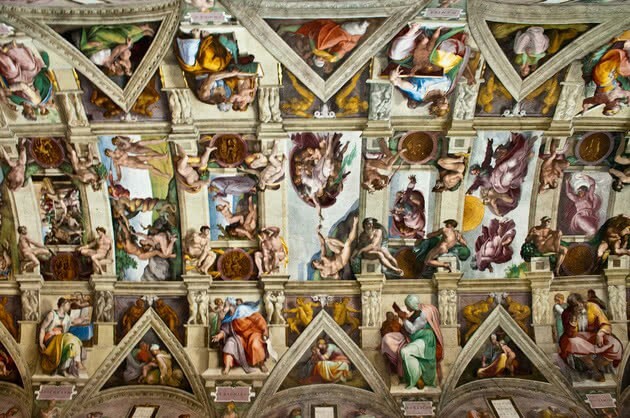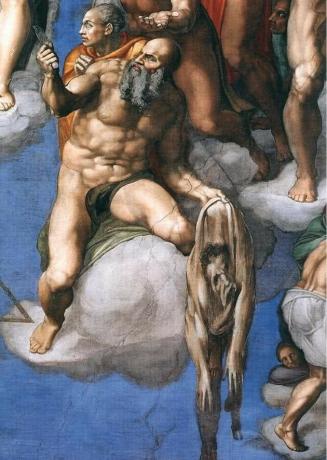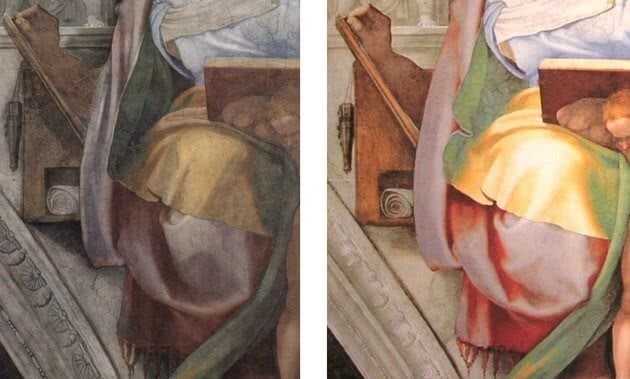Ceiling frescoes of the Sistine Chapel
In the Sistine Chapel is one of the most emblematic works of the Italian Renaissance, whose fame has spread throughout the world. The ceiling of the Sistine Chapel was frescoed by Michelangelo Buonarroti, popularly known as Michelangelo in the Spanish language. This work was commissioned to the artist by Pope Julius II (1443-1513).
Like Michelangelo, he manifested a declared preference for sculpture, a discipline to which he he considered a superior art and for which he was truly renowned, he accepted the Pope's commission with reluctance.
The work began to be painted in 1508 and was completed in 1512, and it became what it would be an impressive artistic feat, considering that Michelangelo did all of the work only.
Analysis of ceiling paintings

The main division of the ceiling is made in nine panels that represent the scenes from the book of the Genesis. The choice of theological theme establishes a relationship between the principles of human history and the coming of Jesus Christ, even though he is not present in the pictorial composition of the the ceiling.
The figures, although pictorial, are influenced by the artist's sculptural perspective and, at the same time, the importance of drawing is perceived. In the same way, the images reveal the mastery of the artist in the representation and knowledge of the human anatomy.
These figures are predominantly robust, energetic, and powerful, yet graceful. Across the space the gigantic and muscular images contort almost impossible, which gives movement to the entire composition and also great energy.
This vivacity of the composition is certainly an evidence of the historical moment that Italy lived and that was expanding throughout Europe. It was not only about the revival of classical art, but also about a rediscovery of Greek philosophy and humanism.
A new Europe was being born, leaving the Middle Ages behind and opening the Modern Age, which made the human being the center of the world, what was called anthropocentrism.
The nine panels tell the story of creation. The first represents the separation of light and darkness; the second portrays the creation of the sun, the moon and the planets; the third represents the moment when the land is separated from the sea.
Adan creation

The fourth panel of the ceiling is dedicated to the creation of Adam, and is one of the most widespread and recognized images worldwide. Here Adam lies languidly reclining, as if he lacked energy, forcing God to give the last effort to touch Adam's fingers and give him a spark of life.
Contrary to the seemingly lazy figure of Adam, God is endowed with movement and energy and even his hair moves with an invisible breeze. Under her left arm, God holds Eve intimately. Eve patiently waits for Adam to receive the light of life so that she can receive it too.
In the fifth panel (the central one) the creation of Eva is finally seen; the sixth represents the expulsion of Adam and Eve from paradise; in the seventh the sacrifice of Noah is represented; in the eighth, the universal flood and in the ninth, finally, the drunkenness of Noah.
On the sides of the panels the prophets (Zechariah, Joel, Isaiah, Ezekiel, Daniel, Jeremiah and Jonah) and the sibyls (Delphic, Eritrea, Cumana, Persian and Libyan) are represented alternately. Michelangelo thus makes a juxtaposition between Christianity and paganism, which some critics interpret as a subtle way of criticizing the Catholic Church.
The panels, as well as the rest of the pictorial composition, are framed by architectural elements painted with extreme realism and with which the figures interact. Some sit and others lean on these false architectural elements.
In the four corners of the ceiling, called pendentives, the representation of the four emblematic stories of the salvation of Israel and, scattered across the center of the composition, twenty seated nude male figures, known What "Ignudi", a name attributed by the artist himself.
These figures appear in pairs of four, surrounding five of the nine ceiling panels, specifically those representing the intoxication of Noah, the sacrifice of Noah, the creation of Eve, the separation of the sea and the earth and the separation of light and darkness.
It may interest you: Fresco The Creation of Adam by Michelangelo: Analysis and Meaning.
The final judgement

Michelangelo returned to the Sistine Chapel more than 20 years later to execute the fresco The final judgement (1536-1541), which is located on the wall of the altar. This work was entrusted to Michelangelo by Pope Clement VII (1478-1534), but the work would only begin after his death, during the pontificate of Paul III (1468-1549).
Contrasting with the vitality, rhythm and radiant energy of the ceiling frescoes, the representation of the final judgment is grim and, at the same time, it is a composition of bodies without real structure. In total, three hundred and ninety bodies that were originally naked are represented, including the Virgin Mary.
The composition is dominated by the central figure of an implacable and fearsome Judge Christ. In the background the sky is torn and in the lower part the angels sound trumpets announcing the final judgment.
Beside Christ the Virgin looks to the side as if refusing to face chaos, misery, suffering and the fact that sinners will be thrown into hell.
One of the figures represented is Saint Bartholomew, who holds his sacrificial knife in one hand and his flayed skin in the other, on which Michelangelo paints his own face. Thus, the deformed face of the flayed skin is that of the artist, perhaps with the intention of making a metaphor about his tortured soul.

The differences between the paintings on the ceiling and on the altar wall are related to the cultural and political context at the time it was made.
At that time Europe was experiencing a spiritual and political crisis. The Reformation years began, which would lead to the division of the Church, before which this composition seems a warning to the enemies of the Church. There is no forgiveness, for Christ is relentless.
As Michelangelo painted these nude figures, the controversy grew over the years, with many accusing the Church of hypocrisy and judging the work as pornographic.
For more than twenty years the slanderers of the work were dedicated to spreading the idea that the Church was protecting a pornographic speech in one of her main facilities, which was accompanied by a campaign to destroy the images.
Fearing the worst, Pope Clement VII commissioned that some of the nude bodies in the composition be repainted, in an attempt to preserve the work and prevent destruction. This work was done by Daniele da Volterra in the year Michelangelo died.
Restoration work
Restoration interventions made to the Sistine Chapel between 1980 and 1994 revealed a side of Michelangelo that had been unintentionally ignored by historians.
Until then, the elements exalted by criticism were reduced to shapes and drawing to the detriment of color. But cleaning centuries of dirt and smoke from the candles revealed a vibrant color palette in Michelangelo's original work. In this way it was proved that the artist was not only a genius of drawing and sculpture, but also an excellent colourist at the level of Leonardo da Vinci.

The Sistine Chapel
The Sistine Chapel (1473-1481) is located in the official residence of the Pope called the Apostolic Palace of the Vatican. Its construction was inspired by the Temple of Solomon. It is there where the Pope celebrates Mass on time and it is also there that the conclave meets to elect the new pontiff.
The Chapel served as a workshop for some of the greatest artists of the Italian Renaissance, not just Michelangelo. Among them are Rafael, Bernini and Botticelli. But it is undeniable that today the simple mention of the Sistine brings us back to the grandiose ceiling and altar frescoes executed by Michelangelo.

Michelangelo Buonarotti
Michelangelo (1475-1564) was one of the greatest artists of the Renaissance and is considered one of the greatest art geniuses of all time. Even in life he enjoyed such recognition and he attributed abilities above the average.
Difficult to deal with, his genius was recognized since he was very young. He frequented the workshop of Domenico Ghirlandaio and at the age of 15 Lorenzo II de Medici took it under his protection.
He was a humanist and was fascinated by the heritage of classical antiquity, which at that time was going through the most important phase of historical revisionism. Therefore, Michelangelo's work focused on the human image as a vehicle of expression. This preference is indisputable evidence of the strong influence that classical sculpture had on the artist.
It may interest you: The 25 most representative paintings of the Renaissance
(Text translated by Andrea Imaginario).



